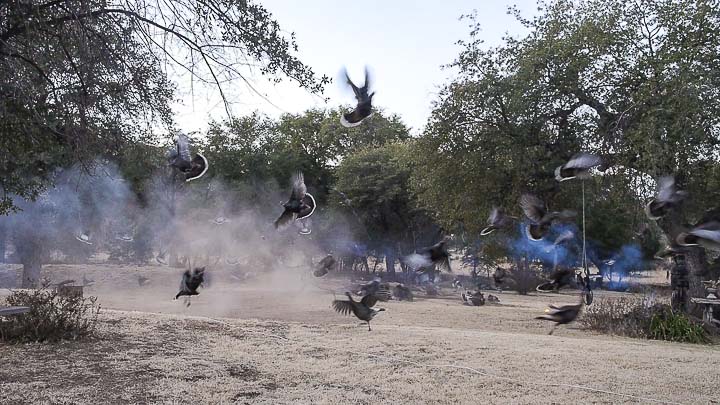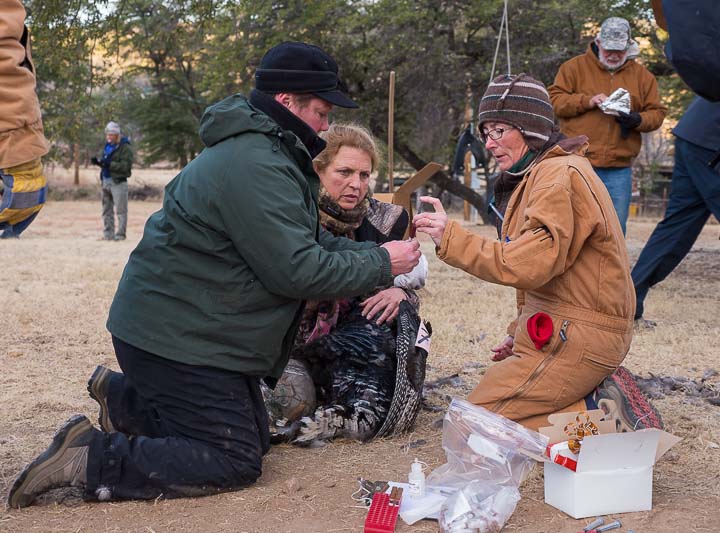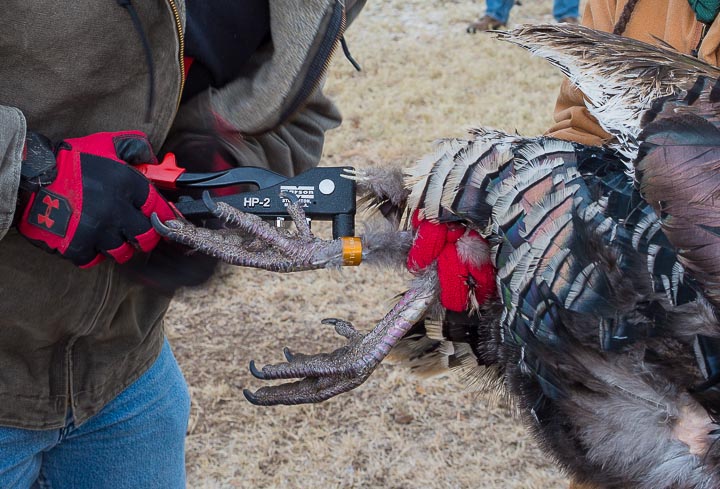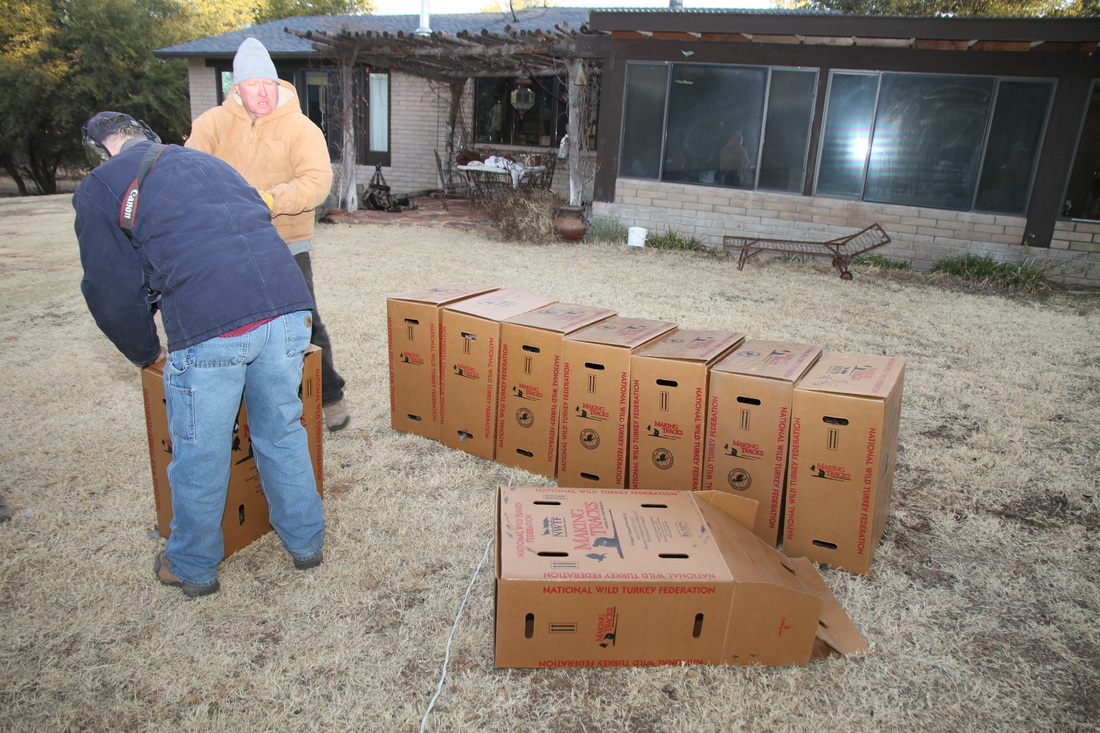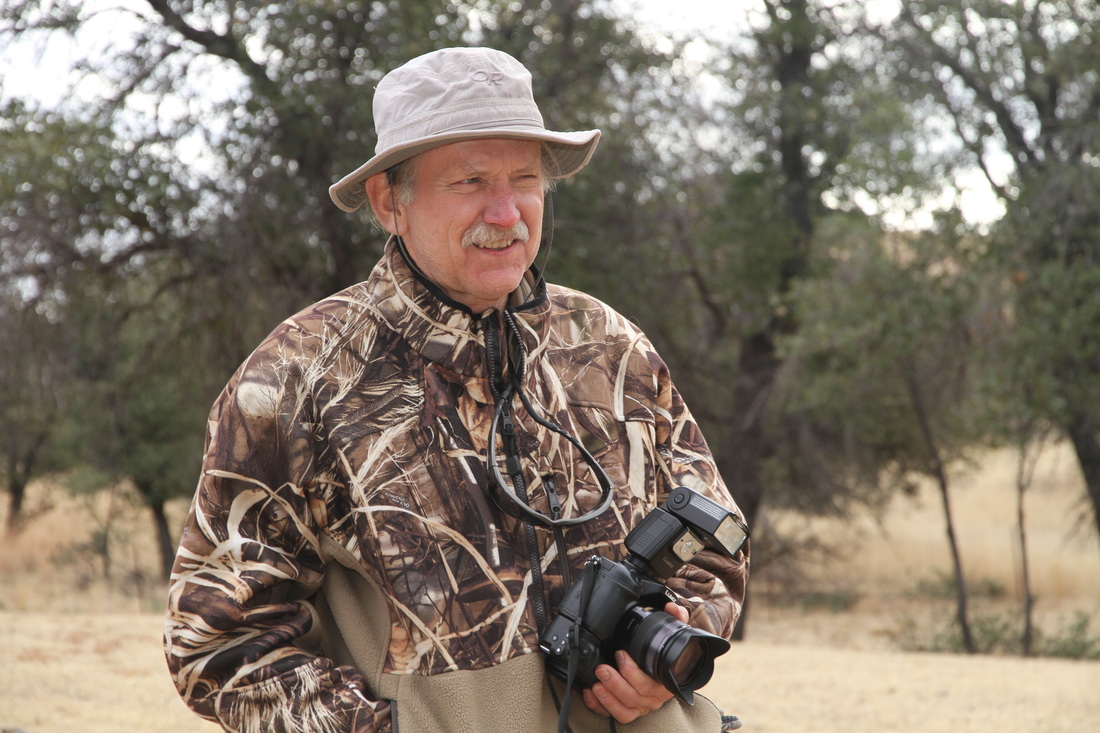Pronghorn released in
Elgin-Sonoita area and San Rafael Valley
Dana Cole, Herald/Review, [email protected], Wed, 01/15/2014 - 7:42pm

ELGIN – Forty-one Pronghorn antelope were released
in the Sonoita-Elgin area and San Rafael Valley of southeastern Arizona
Wednesday, marking the start of an effort to supplement the
region’s dwindling herd.
The Arizona Game and Fish Department, in partnership with the Arizona Antelope Foundation and Tombstone High School Future Farmers of America (FFA) students, are working collaboratively on the project that will involve monitoring the animals’ movements, data collection and habitat studies. The first release, south of Elgin on the Babacomari Ranch, included 18 does and six bucks, with two of each sex fitted with Global Positioning System (GPS) radio collars for monitoring purposes. Another 17 were released south of that site in the San Rafael Valley.
“This was a very successful capture and trans-location,” Amber Munig, the Big Game Management Supervisor for Arizona Game and Fish Department said immediately following the first release. “They all came out of the boxes well and we’re optimistic about how they’re going to do.”
The antelope were captured by the New Mexico Game and Fish Department outside of Cimarron, N.M. on Tuesday, and transported to the area by truck. At the time of the capture, each animal was checked by a veterinarian, blood was drawn, horns were clipped to prevent injury while being transported, and ear tags were attached to the animals to help with herd monitoring.
“The ear tags at one release site are a different color than what are used at the second site,” said Glen Dickens, current vice president of the Arizona Antelope Foundation. “We want to look at herd movement within different release sites, and interaction between herds. We’re looking for connectivity from one site to the next. This is a three year initiative between Arizona Game and Fish and the Antelope Foundation. We’ve received a $230,000 grant for this project, where we’ve modified about 36 miles of fences to help improve connectivity and we’ve purchased GPS collars we’ll be using for monitoring purposes.”
Austin Parker, one of the FFA students involved with the relocation, said the Tombstone High School (THS) FFA has been working on the fence modification project, which involves removing the bottom strand of barbed wire on ranches and other properties and replacing it with smooth wire.
“One of the things we’ve learned through this project is that pronghorn don’t jump fences, they go under them,” he explained. “They’re amazingly fast when they do it; they just throw their head back, race under the fence and keep going. We’ve been working on the fencing all through this area where the antelope will be moving around and grazing.”
Along with fencing, other habitat improvements include water developments, predator management and clearing invasive plants, said Brian Wakeling, who is the Game Branch Chief for Arizona Game and Fish out of Phoenix. “This project represents a collaborative effort between the property owners, ranchers, the Arizona Antelope Foundation, Game and Fish and a number of entities,” he said.
Other organizations involved in the pronghorn relocation include the Arizona Community Foundation, which provided a $10,000 grant that was used to purchase four of the 20 GPS collars placed on the antelope. In addition, as part of its education program, the Natural Resource Conservation District (NRCD) sponsors the Tombstone High School FFA, said Rachel Thomas, vice president of the NRCD.
“It was because of the NRCD that the Tombstone FFA became involved in this project,” said Kelly Lyda, THS agriculture teacher and FFA sponsor. “It’s been an educational and fun experience for them.”
The FFA students will be participating in a pronghorn capture in the Prescott area at the end of the month, said Thomas.
“Some of those antelope will be released on the Empire Ranch, north of where we were today,” she added. “We are very proud of the FFA students and all the hard work they’ve put into this program since it started. It’s going to be interesting to see how well the pronghorn do once they’re established in their new surroundings.”
This is the first antelope release in the Elgin area since the early ’50s, said John Millican, project manager for the Arizona Antelope Foundation.
“I think this trans-location has the best opportunity for success because of all the habitat enhancement we’ve done through the past 10 years, particularly in the last two years. We’ve developed some great partnerships and funding opportunities. And we’ve had great cooperation from private property owners and the ranching community when it comes to fencing and habitat enhancements.”
Millican says the goal is for an antelope population of 200 in that area. “This is just the beginning,” he said.
Exchange with New Mexico
In exchange for the Pronghorn antelope, Arizona will be providing New Mexico Game and Fish with 60 Gould’s turkeys, with the first capture and relocation sometime in February. Gould’s turkey populations have been successfully restored in southeastern Arizona through the efforts of the Arizona Game and Fish Department, according to Mark Hart, the department’s public information officer. Once gone from the region, Hart said there are now 1,000 Gould’s turkeys in the Sky Island mountain range.
The Arizona Game and Fish Department, in partnership with the Arizona Antelope Foundation and Tombstone High School Future Farmers of America (FFA) students, are working collaboratively on the project that will involve monitoring the animals’ movements, data collection and habitat studies. The first release, south of Elgin on the Babacomari Ranch, included 18 does and six bucks, with two of each sex fitted with Global Positioning System (GPS) radio collars for monitoring purposes. Another 17 were released south of that site in the San Rafael Valley.
“This was a very successful capture and trans-location,” Amber Munig, the Big Game Management Supervisor for Arizona Game and Fish Department said immediately following the first release. “They all came out of the boxes well and we’re optimistic about how they’re going to do.”
The antelope were captured by the New Mexico Game and Fish Department outside of Cimarron, N.M. on Tuesday, and transported to the area by truck. At the time of the capture, each animal was checked by a veterinarian, blood was drawn, horns were clipped to prevent injury while being transported, and ear tags were attached to the animals to help with herd monitoring.
“The ear tags at one release site are a different color than what are used at the second site,” said Glen Dickens, current vice president of the Arizona Antelope Foundation. “We want to look at herd movement within different release sites, and interaction between herds. We’re looking for connectivity from one site to the next. This is a three year initiative between Arizona Game and Fish and the Antelope Foundation. We’ve received a $230,000 grant for this project, where we’ve modified about 36 miles of fences to help improve connectivity and we’ve purchased GPS collars we’ll be using for monitoring purposes.”
Austin Parker, one of the FFA students involved with the relocation, said the Tombstone High School (THS) FFA has been working on the fence modification project, which involves removing the bottom strand of barbed wire on ranches and other properties and replacing it with smooth wire.
“One of the things we’ve learned through this project is that pronghorn don’t jump fences, they go under them,” he explained. “They’re amazingly fast when they do it; they just throw their head back, race under the fence and keep going. We’ve been working on the fencing all through this area where the antelope will be moving around and grazing.”
Along with fencing, other habitat improvements include water developments, predator management and clearing invasive plants, said Brian Wakeling, who is the Game Branch Chief for Arizona Game and Fish out of Phoenix. “This project represents a collaborative effort between the property owners, ranchers, the Arizona Antelope Foundation, Game and Fish and a number of entities,” he said.
Other organizations involved in the pronghorn relocation include the Arizona Community Foundation, which provided a $10,000 grant that was used to purchase four of the 20 GPS collars placed on the antelope. In addition, as part of its education program, the Natural Resource Conservation District (NRCD) sponsors the Tombstone High School FFA, said Rachel Thomas, vice president of the NRCD.
“It was because of the NRCD that the Tombstone FFA became involved in this project,” said Kelly Lyda, THS agriculture teacher and FFA sponsor. “It’s been an educational and fun experience for them.”
The FFA students will be participating in a pronghorn capture in the Prescott area at the end of the month, said Thomas.
“Some of those antelope will be released on the Empire Ranch, north of where we were today,” she added. “We are very proud of the FFA students and all the hard work they’ve put into this program since it started. It’s going to be interesting to see how well the pronghorn do once they’re established in their new surroundings.”
This is the first antelope release in the Elgin area since the early ’50s, said John Millican, project manager for the Arizona Antelope Foundation.
“I think this trans-location has the best opportunity for success because of all the habitat enhancement we’ve done through the past 10 years, particularly in the last two years. We’ve developed some great partnerships and funding opportunities. And we’ve had great cooperation from private property owners and the ranching community when it comes to fencing and habitat enhancements.”
Millican says the goal is for an antelope population of 200 in that area. “This is just the beginning,” he said.
Exchange with New Mexico
In exchange for the Pronghorn antelope, Arizona will be providing New Mexico Game and Fish with 60 Gould’s turkeys, with the first capture and relocation sometime in February. Gould’s turkey populations have been successfully restored in southeastern Arizona through the efforts of the Arizona Game and Fish Department, according to Mark Hart, the department’s public information officer. Once gone from the region, Hart said there are now 1,000 Gould’s turkeys in the Sky Island mountain range.
New Mexico
Department of Game and Fish
Media contact: Rachel Shockley, (505) 476-8071; (505) 470-6832 (cell)
Public contact: (888) 248-6866
[email protected]
FOR IMMEDIATE RELEASE, JAN. 22, 2014:
DEPARTMENT RELOCATES PRONGHORN TO SOUTHERN NM; TRADES 43 FOR GOULD’S TURKEY
CIMARRON, NM – New Mexico has larger pronghorn herds in southern New Mexico and will soon have larger flocks of Gould’s turkeys in the Peloncillo and Animas-San Luis Mountains thanks to the successes of a recent pronghorn trap operation near Cimarron, NM.
New Mexico Department of Game and Fish biologists, conservation officers and staff captured over 200 pronghorn from irrigated croplands on a ranch in northern New Mexico. The pronghorn received blood tests, vaccinations and were fitted with radio collars before being relocated on Bureau of Land Management sites outside of Fort Stanton, near Capitan and northwest of Roswell. In exchange for a flock of 60 Gould’s turkeys, forty-three pronghorn were relocated to Arizona.
"New Mexicans benefit on multiple fronts from the outcome of this trap," said Interim Director R.J. Kirkpatrick. "Southern New Mexico pronghorn herds increase in size, the trade with Arizona provides critical new birds to augment our turkey populations and New Mexicans can enjoy opportunities to see more wildlife in their natural habitat.”
The Department began trapping and transplanting pronghorns to new ranges in New Mexico in the 1930s and continues the practice today. The statewide population now has grown to approximately 30,000 pronghorn.
Media contact: Rachel Shockley, (505) 476-8071; (505) 470-6832 (cell)
Public contact: (888) 248-6866
[email protected]
FOR IMMEDIATE RELEASE, JAN. 22, 2014:
DEPARTMENT RELOCATES PRONGHORN TO SOUTHERN NM; TRADES 43 FOR GOULD’S TURKEY
CIMARRON, NM – New Mexico has larger pronghorn herds in southern New Mexico and will soon have larger flocks of Gould’s turkeys in the Peloncillo and Animas-San Luis Mountains thanks to the successes of a recent pronghorn trap operation near Cimarron, NM.
New Mexico Department of Game and Fish biologists, conservation officers and staff captured over 200 pronghorn from irrigated croplands on a ranch in northern New Mexico. The pronghorn received blood tests, vaccinations and were fitted with radio collars before being relocated on Bureau of Land Management sites outside of Fort Stanton, near Capitan and northwest of Roswell. In exchange for a flock of 60 Gould’s turkeys, forty-three pronghorn were relocated to Arizona.
"New Mexicans benefit on multiple fronts from the outcome of this trap," said Interim Director R.J. Kirkpatrick. "Southern New Mexico pronghorn herds increase in size, the trade with Arizona provides critical new birds to augment our turkey populations and New Mexicans can enjoy opportunities to see more wildlife in their natural habitat.”
The Department began trapping and transplanting pronghorns to new ranges in New Mexico in the 1930s and continues the practice today. The statewide population now has grown to approximately 30,000 pronghorn.
GOULD’S TURKEY RELOCATION 2014
Initial Report of Activity
So far in 2014, 2 days of trapping have been conducted by Arizona Game and Fish Department. The translocation of birds this year is part of a 3-year cooperative trade with the New Mexico Department of Fish and Game. In exchange for Gould’s Turkeys, Arizona will receive Pronghorns for release. Turkeys going to New Mexico will find a new home in the southwestern part of that state. A few of the captured birds will stay in southeastern Arizona in order to secure additional field data on the species.
A cannon box net was set up in the Canelo Hills of Santa Cruz County. In 2 days of trapping over 20 birds were caught.
Volunteers from The Huachuca Gould’s Chapter of the National Wild Turkey Federation once again gave experienced help in the captures. The Chapter even provided breakfast burritos this time!
Assisting as well were members of the University of Arizona Chapter of The Wildlife Society. Private land owner cooperation was again very crucial.
The following short video was shot early on the morning of the first day. Included images come from both days.
Another update will come with additional trapping activity. Video, story, and still photos were done by Tom Deecken.
Initial Report of Activity
So far in 2014, 2 days of trapping have been conducted by Arizona Game and Fish Department. The translocation of birds this year is part of a 3-year cooperative trade with the New Mexico Department of Fish and Game. In exchange for Gould’s Turkeys, Arizona will receive Pronghorns for release. Turkeys going to New Mexico will find a new home in the southwestern part of that state. A few of the captured birds will stay in southeastern Arizona in order to secure additional field data on the species.
A cannon box net was set up in the Canelo Hills of Santa Cruz County. In 2 days of trapping over 20 birds were caught.
Volunteers from The Huachuca Gould’s Chapter of the National Wild Turkey Federation once again gave experienced help in the captures. The Chapter even provided breakfast burritos this time!
Assisting as well were members of the University of Arizona Chapter of The Wildlife Society. Private land owner cooperation was again very crucial.
The following short video was shot early on the morning of the first day. Included images come from both days.
Another update will come with additional trapping activity. Video, story, and still photos were done by Tom Deecken.
The above video was taken from the first angle by Huachuca Gould's Chapter Board Member, Tom Deecken
(RESIZING, Check back soon!) The above video was taken from a second angle by Huachuca Gould's President, John Millican
The below photos were taken by John Millican
|
|
Story and Photo was in the Herald/Review on Wednesday February 5th 2014
"San Rafael Valley" is the correct spelling...
Waiting release Photos from New Mexico Game and Fish
Waiting release Photos from New Mexico Game and Fish

